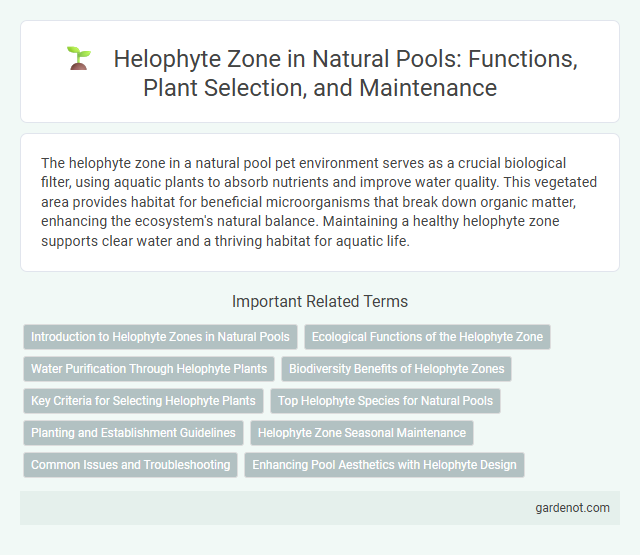The helophyte zone in a natural pool pet environment serves as a crucial biological filter, using aquatic plants to absorb nutrients and improve water quality. This vegetated area provides habitat for beneficial microorganisms that break down organic matter, enhancing the ecosystem's natural balance. Maintaining a healthy helophyte zone supports clear water and a thriving habitat for aquatic life.
Introduction to Helophyte Zones in Natural Pools
Helophyte zones in natural pools serve as essential biological filters, utilizing rooted aquatic plants like reeds and sedges to purify water by absorbing nutrients and trapping sediments. These zones create a balanced aquatic ecosystem, supporting biodiversity and enhancing water clarity without chemical treatments. Proper design and maintenance of helophyte zones ensure efficient natural filtration and contribute to the overall health and sustainability of natural swimming pools.
Ecological Functions of the Helophyte Zone
The helophyte zone in a natural pool serves as a critical biofilter, utilizing dense root systems of emergent plants to absorb excess nutrients such as nitrogen and phosphorus, thereby preventing algal blooms. This zone enhances water clarity through sediment stabilization and promotes oxygenation, supporting aerobic microbial communities essential for organic matter decomposition. By providing habitat complexity, the helophyte zone fosters biodiversity, offering refuge and breeding grounds for aquatic invertebrates and amphibians.
Water Purification Through Helophyte Plants
Helophyte plants play a crucial role in natural pool water purification by absorbing nutrients and filtering out pollutants from the water. Their dense root systems promote microbial activity, which breaks down organic matter and harmful substances effectively. This biological filtration enhances water clarity and maintains a balanced ecosystem without the need for chemical treatments.
Biodiversity Benefits of Helophyte Zones
Helophyte zones in natural pools significantly enhance biodiversity by providing habitat for diverse aquatic plants and microorganisms, which support a balanced ecosystem. These zones improve water quality through natural filtration, creating optimal conditions for fish, amphibians, and beneficial insects to thrive. The complex root systems of helophytes stabilize sediment and reduce erosion, further promoting a rich and sustainable aquatic environment.
Key Criteria for Selecting Helophyte Plants
Helophyte plants in natural pool helophyte zones require high tolerance to waterlogged conditions and efficient nutrient uptake to maintain water clarity. Selecting species with robust root systems and high biomass production supports filtration and reduces algae growth. Native helophytes like Typha, Phragmites, and Schoenoplectus maximize ecological balance and enhance biodiversity in the filtration zone.
Top Helophyte Species for Natural Pools
Top helophyte species for natural pools include common reed (Phragmites australis), bulrush (Schoenoplectus spp.), and cattails (Typha latifolia), which excel in filtering and oxygenating water. These plants thrive in shallow waters, supporting the biodegradation of pollutants and providing crucial habitat for aquatic wildlife. Incorporating diverse helophytes enhances the ecological balance and water clarity of natural swimming pools.
Planting and Establishment Guidelines
The helophyte zone in natural pools requires planting with wetland species such as cattails, reeds, and sedges to enhance water filtration and habitat diversity. Plants should be established in nutrient-rich, well-drained substrates at water depths ranging from 10 to 40 centimeters to optimize growth and ecological function. Regular monitoring and maintenance during the initial establishment phase, typically the first two growing seasons, ensure successful root development and overall system stability.
Helophyte Zone Seasonal Maintenance
Helophyte zone seasonal maintenance involves removing accumulated debris and dead plant matter to ensure optimal water filtration and ecosystem health. Regular trimming of emergent plants promotes vigorous growth, preventing clogging and maintaining clear water flow in the natural pool. Seasonal inspections detect potential blockages or plant diseases early, preserving the balance of the helophyte filtration system.
Common Issues and Troubleshooting
Helophyte zones in natural pools often face challenges like clogging from decaying plant material and reduced oxygen levels, which can impair water filtration and clarity. Regular maintenance such as removal of dead vegetation and ensuring proper water flow helps prevent stagnation and nutrient buildup. Monitoring plant health and balancing species diversity are key strategies to mitigate algae overgrowth and maintain effective biofiltration.
Enhancing Pool Aesthetics with Helophyte Design
Helophyte zones, integrated into natural pools, significantly enhance pool aesthetics by introducing lush, native plants like cattails and reeds that create a vibrant, living border. These zones not only add visual interest with varied textures and colors but also contribute to a naturalistic, tranquil ambiance. Incorporating helophyte design supports water clarity by facilitating natural filtration and nutrient uptake, blending ecological function with seamless beauty.
Helophyte zone Infographic

 gardenot.com
gardenot.com